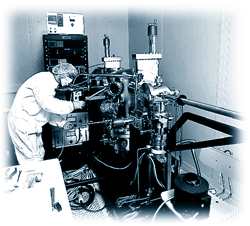 Developing the world's fastest resonance photodetector won Bilkent University Physics Department researchers recognition in the July issue of Laser Focus World, a leading optoelectronics journal.
Developing the world's fastest resonance photodetector won Bilkent University Physics Department researchers recognition in the July issue of Laser Focus World, a leading optoelectronics journal.
Manufactured by Dr. Ekmel Özbay and his graduate students, the new photodetector performs four times better than previously developed photodetectors, according to standard scientific measures that take speed and efficiency into account. The photodetector, which makes use of resonant cavity enhanced Schottky photodiodes, receives signals from fiber optic lines and translates them into a format that can be used by devices such as computers and telephones.
The new high-speed photodetector could make communication networks less expensive and allow users to access more information in less time. For example, in a long-distance computer network fewer of the enhanced-efficiency photodetectors would be necessary to transmit information, decreasing the network's overall cost, while the photodetectors' improved speed would move more information such as web pages from fiber optic lines to computer screens . The Newsbreaks section of the journal cites Dr. Özbay's published research documenting development of the photodetector at Bilkent University.








